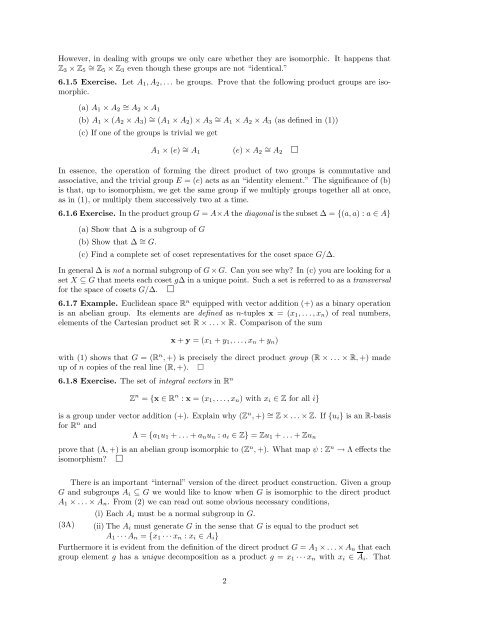Algebra I: Section 6. The structure of groups. 6.1 Direct products of ...
Algebra I: Section 6. The structure of groups. 6.1 Direct products of ...
Algebra I: Section 6. The structure of groups. 6.1 Direct products of ...
Create successful ePaper yourself
Turn your PDF publications into a flip-book with our unique Google optimized e-Paper software.
However, in dealing with <strong>groups</strong> we only care whether they are isomorphic. It happens that<br />
Z3 × Z5 ∼ = Z5 × Z3 even though these <strong>groups</strong> are not “identical.”<br />
<strong>6.</strong>1.5 Exercise. Let A1, A2, . . . be <strong>groups</strong>. Prove that the following product <strong>groups</strong> are isomorphic.<br />
(a) A1 × A2 ∼ = A2 × A1<br />
(b) A1 × (A2 × A3) ∼ = (A1 × A2) × A3 ∼ = A1 × A2 × A3 (as defined in (1))<br />
(c) If one <strong>of</strong> the <strong>groups</strong> is trivial we get<br />
A1 × (e) ∼ = A1 (e) × A2 ∼ = A2 �<br />
In essence, the operation <strong>of</strong> forming the direct product <strong>of</strong> two <strong>groups</strong> is commutative and<br />
associative, and the trivial group E = (e) acts as an “identity element.” <strong>The</strong> significance <strong>of</strong> (b)<br />
is that, up to isomorphism, we get the same group if we multiply <strong>groups</strong> together all at once,<br />
as in (1), or multiply them successively two at a time.<br />
<strong>6.</strong>1.6 Exercise. In the product group G = A×A the diagonal is the subset ∆ = {(a, a) : a ∈ A}<br />
(a) Show that ∆ is a subgroup <strong>of</strong> G<br />
(b) Show that ∆ ∼ = G.<br />
(c) Find a complete set <strong>of</strong> coset representatives for the coset space G/∆.<br />
In general ∆ is not a normal subgroup <strong>of</strong> G ×G. Can you see why? In (c) you are looking for a<br />
set X ⊆ G that meets each coset g∆ in a unique point. Such a set is referred to as a transversal<br />
for the space <strong>of</strong> cosets G/∆. �<br />
<strong>6.</strong>1.7 Example. Euclidean space R n equipped with vector addition (+) as a binary operation<br />
is an abelian group. Its elements are defined as n-tuples x = (x1, . . . , xn) <strong>of</strong> real numbers,<br />
elements <strong>of</strong> the Cartesian product set R × . . . × R. Comparison <strong>of</strong> the sum<br />
x + y = (x1 + y1, . . .,xn + yn)<br />
with (1) shows that G = (R n , +) is precisely the direct product group (R × . . . × R, +) made<br />
up <strong>of</strong> n copies <strong>of</strong> the real line (R, +). �<br />
<strong>6.</strong>1.8 Exercise. <strong>The</strong> set <strong>of</strong> integral vectors in R n<br />
Z n = {x ∈ R n : x = (x1, . . . , xn) with xi ∈ Z for all i}<br />
is a group under vector addition (+). Explain why (Z n , +) ∼ = Z × . . . × Z. If {ui} is an R-basis<br />
for R n and<br />
Λ = {a1u1 + . . . + anun : ai ∈ Z} = Zu1 + . . . + Zun<br />
prove that (Λ, +) is an abelian group isomorphic to (Z n , +). What map ψ : Z n → Λ effects the<br />
isomorphism? �<br />
<strong>The</strong>re is an important “internal” version <strong>of</strong> the direct product construction. Given a group<br />
G and sub<strong>groups</strong> Ai ⊆ G we would like to know when G is isomorphic to the direct product<br />
A1 × . . . × An. From (2) we can read out some obvious necessary conditions,<br />
(i) Each Ai must be a normal subgroup in G.<br />
(3A) (ii) <strong>The</strong> Ai must generate G in the sense that G is equal to the product set<br />
A1 · · ·An = {x1 · · · xn : xi ∈ Ai}<br />
Furthermore it is evident from the definition <strong>of</strong> the direct product G = A1 ×...×An that each<br />
group element g has a unique decomposition as a product g = x1 · · ·xn with xi ∈ Ai. That<br />
2

















